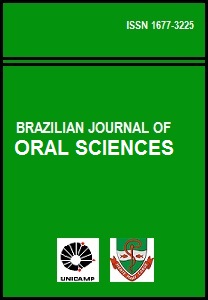Abstract
Aim: This study evaluated the proximity and relation of impacted lower third molars and mandibular canal on panoramic radiography. Methods: Radiographic signals associated with proximity of structures and Pell & Gregory and Winter classifications of 78 impacted teeth were analyzed and compared with CBCT images (gold standard). The associations between the findings were tested with Pearson’s chi-square. Results: Direct contact between structures was observed in 85% of cases of radiolucent band over roots. Conclusions: Radiolucent band over roots is the image more associated with direct contact between structures and the one that indicates lingual positioning of the canal more consistently. Some categories of Pell & Gregory and Winter classifications suggested signs of the topographic location of the mandibular canal.The Brazilian Journal of Oral Sciences uses the Creative Commons license (CC), thus preserving the integrity of the articles in an open access environment.
Downloads
Download data is not yet available.

